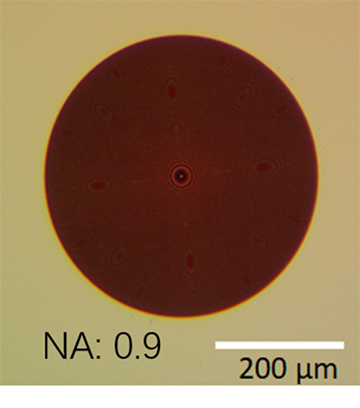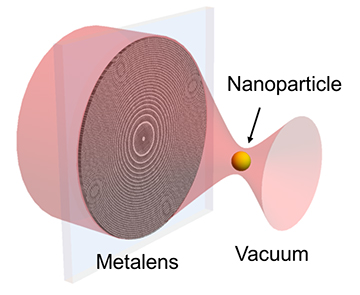
Optical image of the metalens used by a team of U.S.-based researchers to create chip-based optical tweezers that can optically levitate nanoparticles in a vacuum. The diameter of the metalens was about 50 times smaller than that of a conventional objective lens that they used before. [Image: T. Li, Purdue University]
Optical tweezers, which use laser beams to manipulate tiny particles, might seem perfect for incorporating into lab-on-a-chip experiments. But the bulky objective lenses needed for a tight focus of the light throw a wrench into miniaturization of the tweezers.
Researchers at two U.S. universities have incorporated metamaterial technology into a thin dielectric metalens that provides the high numerical aperture needed for a beam that can manipulate tiny particles (Optica, doi:10.1364/OPTICA.438410). With the lens, the team levitated a nanoparticle in a vacuum environment and transferred it between two separated optical tweezers.
Nanopillars of silicon
Metasurfaces and metamaterials consist of carefully designed structures that control the properties of light passing between them. Lenses made of metamaterials and filled with fluid have been used in optical trapping, but some applications require air or vacuum manipulation.
The research group led by physicist Tongcang Li of Purdue University, USA, and electrical engineer Xingjie Ni of the Pennsylvania State University, USA, designed the lens with a diameter of 425 μm and a focal length of 100 μm. To fabricate it, the scientists deposited a 500-nm-thick layer of amorphous silicon onto a sapphire substrate and etched the pattern of nanopillars with electron beam lithography. The resulting forest of 500-nm-tall pillars yielded a numerical aperture of 0.9 with 1064-nm-wavelength laser light under high-vacuum conditions.
While the 1064-nm light focused with the metalens levitated a 170-nm-diameter nanoparticle, the team used scattered light from a 532-nm-wavelength laser to illuminate the optical trap for imaging.

Schematic of optically levitating a nanoparticle with a metalens in a vacuum. The metalens focuses a laser beam to create chip-based optical tweezers. [Image: K. Shen, Purdue University]
Nanoparticle ping-pong
Once the scientists had demonstrated levitation with a single metalens optical trap, they pushed the nanoparticle back and forth between two optical tweezers, one with the metalens and the other with a conventional objective lens. The particle jumped between the two potential wells about 1.5 μm apart, depending on which tweezers’ laser power dropped to near zero.
Li notes that the conventional objective lens for optical-tweezers experiments is about 25 mm wide and about 50 mm long—five orders of magnitude higher than the thickness of the metalens.
To the best of Li and Ni’s knowledge, this was the first demonstration of levitation of a nanoparticle in a vacuum by optical tweezers using an ultrathin metalens. Designing the lens to optimize both numerical aperture and focusing efficiency was the group’s biggest challenge. “We redesigned our metalens several times and fabricated multiple metalenses to select the best ones for optical levitation in a vacuum,” Li says.
From here, the research team will work on boosting the tweezers’ focusing efficiency even higher. Li says the metalens tweezers should also work with cells, organelles and biological molecules as well as inorganic particles.
